With the UK basking in a mini-heatwave, the importance of sun protection is paramount.
While the convenience of moisturisers with added SPF is undeniable, relying solely on them for sun protection might not be enough.
Dermatologists and skincare experts say there are key differences between SPF-infused moisturisers and dedicated sunscreens.
Although many daily moisturisers now boast added SPF, their effectiveness as a standalone sun protection method is debatable.
The core difference lies in their formulation. While a moisturiser with SPF offers some level of protection against ultraviolet (UV) rays, it's not designed to provide the same comprehensive shield as a dedicated sunscreen.
SPF, or Sun Protection Factor, measures a product's ability to filter out UV rays. A higher SPF indicates greater protection. However, even if a moisturiser and a sunscreen share the same SPF rating, their distinct formulas can lead to varying levels of protection.

Dedicated sunscreens are specifically formulated to create a uniform barrier against UV rays, while moisturisers with SPF primarily focus on hydration, with sun protection as a secondary benefit. This difference in primary function impacts their effectiveness in shielding the skin from the sun's harmful rays.
Therefore, relying solely on a moisturiser with SPF might leave your skin vulnerable, especially during prolonged sun exposure.
“Moisturisers with SPF are convenient and can offer some degree of sun protection, but they’re absolutely not equivalent to using a standalone dedicated sunscreen,” explains skincare and aesthetics expert Dr Jessica Halliley.
“The key difference is that sunscreens are formulated specifically for UV protection, so they’re tested to perform reliably under sun exposure.
“Moisturisers, on the other hand, are primarily hydration-focused and generally don’t have the same level of coverage or durability,” she explains.
“When you look at the concentration of the SPF proportion on such products, you’d have to apply a huge amount of product to actually get the protection advertised.”
The main difference, therefore, lies in the amount of product you need to apply to get the same level of protection.
“With most moisturisers and make-up products that supposedly contain SPF, what they don’t tell you is how much of that product you would need to put on your face to achieve the SPF rating that it is advertising,” says skin and aesthetics expert Dr Ed Robinson.
“With foundations and some moisturisers, you would need to apply an unrealistic amount onto your face to achieve the desired SPF.”
Do moisturisers with SPF meet the same testing standards as sunscreens?
While you may think any product that contains SPF must undergo the same rigorous testing, this isn’t necessarily the case.
“In the UK and EU, both moisturisers with SPF and dedicated sunscreens are considered cosmetic products and must meet certain testing standards, including SPF efficacy tests,” explains aesthetics and skincare specialist Dr Ellie Sateei.
“However, the level of scrutiny and formulation focus can differ. Sunscreens are typically developed with UV protection as the priority, while in moisturisers, SPF is often a secondary benefit.”
That’s why you shouldn’t assume your moisturiser will offer the same level of protection for the same duration as a dedicated SPF.
How to ensure a moisturiser with SPF is truly protective
While there’s no harm in having added sun protection within your moisturiser, it isn’t something you should wholly rely on.
But if you want to make sure you’re getting some real protection from UVA and UVB rays, there are a few things to look out for on the label.

“Look for the phrase “broad-spectrum” as this means the product protects against both UVA and UVB rays,” says Dr Halliley.
“You’ll also want to see an SPF of 30 or higher.”
Factors are crucial for long-lasting protection.
“Factor 10 only provides 92 per cent protection from the sun,” says Dr Robinson.

“Factor 50 provides 98 per cent.”
“In the UK and Europe, the UVA circle logo is another key indicator of proper UVA protection.”
It’s important to note that while a product label may state it contains SPF, this doesn’t guarantee protection.

“Be cautious of products that simply state “SPF” without further detail,” says Dr Halliley, “as they may not offer enough defence, especially if you’re outdoors or exposed to sunlight for extended periods.”
The solution
While a two-in-one moisturiser and SPF sounds like the perfect solution for sunny days – if you actually want hydration and sun protection – you’re going to have to layer your products.
“Applying a standalone broad-spectrum SPF on top of your moisturiser is the most reliable way to protect your skin,” explains Dr Halliley.
“Think of your moisturiser as your hydration step and your SPF as your final protective shield.”

If you have particularly dry or normal skin, a sunscreen alone won’t be enough to hydrate your skin. “Layering is your friend here,” says Dr Halliley.
“Start with a lightweight hydrating serum or moisturiser, and follow with a broad-spectrum sunscreen.
“If you’re worried about feeling greasy, look for modern SPF formulations like gel creams, fluid textures, or mineral sunscreens with hydrating ingredients such as glycerine or hyaluronic acid.”

But staying hydrated isn’t just down to the products you use.
“You will dehydrate in the sun and from sweating – the body is losing water and so it is important to hydrate from the inside,” explains Dr Robinson.
“A specifically formulated SPF with a moisturising capacity is best if you have dry skin,” he says.
“I prefer the OBAGI range, which contain the most evidence-based SPF products. Intradermology is another great SPF that moisturises too.”

Join our commenting forum
Join thought-provoking conversations, follow other Independent readers and see their replies
Comments